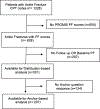Minimal Clinically Important Differences of PROMIS PF in Ankle Fracture Patients
- PMID: 35491661
- PMCID: PMC9256771
- DOI: 10.1177/10711007221091815
Minimal Clinically Important Differences of PROMIS PF in Ankle Fracture Patients
Abstract
Background: Evaluating the minimal clinically important differences (MCIDs) in patient-reported outcome scores is essential for use of clinical outcomes data. The purpose of the current study was to calculate MCID of Patient Reported Outcome Information System Physical Function (PROMIS PF) scores for ankle fracture patients.
Methods: All patients who underwent operative fixation for ankle fractures at a single level 1 trauma center were identified by Current Procedural Terminology code. PROMIS PF scores were collected. Patients had to complete an anchor question at 2 time points postoperatively to be included in this study. Anchor-based and distribution-based MCIDs were calculated.
Results: A total of 331 patients were included in the distribution-based analysis, and 195 patients were included in the anchor-based analysis. Mean age was 45.3 years (SD 17.5), and 59.4% of participants were female. MCID for PROMIS PF scores was 5.05 in the distribution-based method and 5.43 in the anchor-based method.
Conclusion: This study identified MCID values based on 2 time points postoperatively for PROMIS PF scores in the ankle fracture population. Both methods of MCID calculation resulted in equivalent MCIDs. This can be used to identify patients outside the normal preoperative and postoperative norms and may help to make clinically relevant practice decisions.
Level of evidence: Level I, diagnostic study, testing of previously developed diagnostic measure on consecutive patients with reference standard applied.
Keywords: MCID; PROMIS; ankle fracture; physical function.
Conflict of interest statement
Declaration of Conflicting Interests
The author(s) declared no potential conflicts of interest with respect to the research, authorship, and/or publication of this article. ICMJE forms for all authors are available online.
References
-
- Chakravarty EF, Bjorner JB, Fries JF. Improving patient reported outcomes using item response theory and computerized adaptive testing. In: J Rheumatol. Vol 34.; 2007. - PubMed
MeSH terms
Grants and funding
LinkOut - more resources
Full Text Sources
Medical
Research Materials


